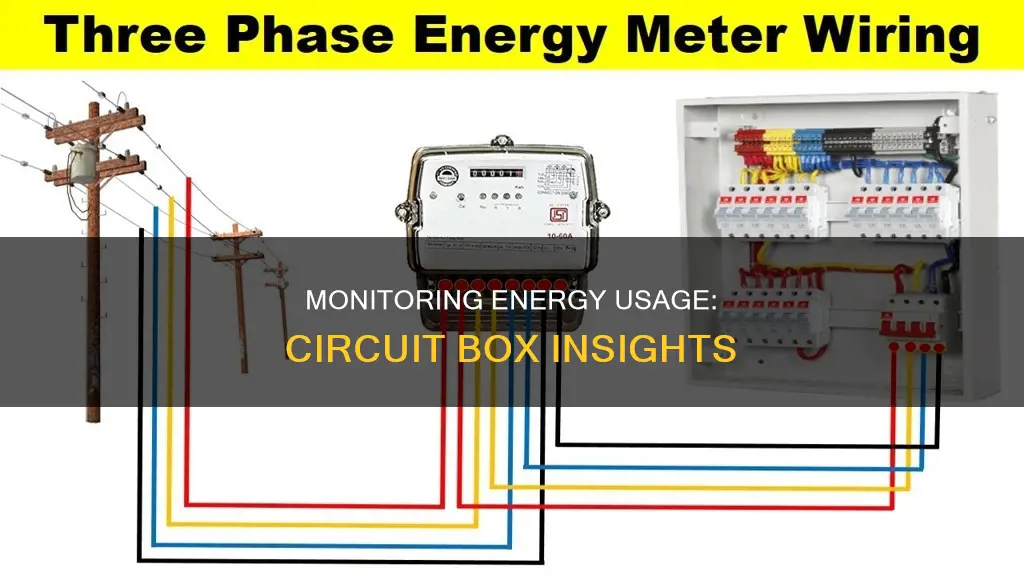
Monitoring energy usage at the circuit box is a great way to understand your electricity usage and identify areas where you can cut down. Energy monitors can be placed next to your circuit box to track your energy usage and provide insights on how to be more energy-efficient. These devices can help you save money on your electricity bills and reduce your carbon footprint. With the data provided by energy monitors, you can make informed decisions about your energy consumption and take control of your energy usage.
| Characteristics | Values |
|---|---|
| Purpose | To monitor energy usage at the circuit box and reduce energy consumption and costs |
| Installation | Next to the electrical panel (breaker box); some require an electrician for installation |
| Functionality | Monitor energy usage at the appliance, circuit, or whole-home level; provide insights and recommendations via a mobile app |
| Features | Real-time data and notifications, appliance recognition, cost tracking, solar-ready options |
| Examples | Sense, Smappee, CURB, Engage, Wiser Energy, Shelly EM, IoTaWatt, CircuitSetup, Emporia Vue, Brultech GreenEye, Lantern Power Monitor |
What You'll Learn
- Energy monitors can be installed by electricians to ensure safety and confidence in the system
- Energy monitors can identify 'vampire energy' leaks and devices that use energy in standby mode
- Energy monitors can be used to identify the most expensive devices to run
- Energy monitors can be used to identify the best time of day to run appliances to save money
- Energy monitors can be used in conjunction with solar panels to increase electricity usage during the day

Energy monitors can be installed by electricians to ensure safety and confidence in the system
Energy monitors are a great way to understand your electricity usage and take control of your energy bills. They can be installed at the circuit box to monitor energy usage at a circuit or appliance level, giving you detailed insights into your energy consumption.
While some energy monitors are marketed as DIY installations, it is always best to consult an electrician to ensure safety and confidence in the system. Electricians will be able to install energy monitors correctly and safely, reducing the risk of any shock hazards. This is especially important when dealing with electrical panels and circuit boxes, as any mistakes can be dangerous and costly.
By hiring a certified electrician, you can be confident that your energy monitor is installed correctly and that the data it provides is accurate and reliable. This accuracy is essential for making informed decisions about your energy usage and can help you identify any issues or areas where you can reduce your consumption.
Additionally, electricians will be able to advise on the best placement of sensors for energy monitors. These sensors may clamp onto the service mains or connect directly to individual circuits, and an electrician can determine the most suitable option for your home. They can also ensure that the energy monitor is compatible with your electrical setup and recommend any necessary adjustments or upgrades.
With a professional installation, you can have peace of mind that your energy monitor is functioning correctly and providing you with valuable insights to help reduce your energy costs and carbon footprint.
Monitor Data Usage: Simple Tips for Combating Overage
You may want to see also

Energy monitors can identify 'vampire energy' leaks and devices that use energy in standby mode
Energy monitors are a great way to identify vampire energy leaks and devices that use energy in standby mode. Vampire energy refers to the electricity consumed by devices that are plugged in but not actively in use. This can include anything from TVs and desktop computers to device chargers and kitchen appliances. While each device only uses a small amount of power, collectively they can constitute a significant portion of your electricity bill.
Energy monitors can help identify these vampire energy sources by tracking your energy consumption and providing insights into how to increase your energy efficiency. They connect to your electricity meter and show how much energy your home uses, as well as provide information on how to make your home more energy-efficient. Some monitors can even recognize the energy usage of individual appliances and generate personalized recommendations.
For example, the Sense Home Energy Monitor installs in your home's electrical panel and provides insights into your energy use and home activity through a mobile app. It can identify specific appliances by recognizing their unique electrical signatures and help you track down those energy vampires.
Another example is the P3 Kill A Watt EZ, a simple plug load monitor that plugs into an outlet, and then you plug your device/appliance into the monitor. It can auto-calculate the amount of energy used over a certain period, helping you identify any vampire devices that are using more energy than they should.
By using energy monitors, you can gain a better understanding of your energy usage and make more informed decisions to reduce your electricity costs and environmental impact.
Uncover Hidden Internet Monitors: A Comprehensive Guide
You may want to see also

Energy monitors can be used to identify the most expensive devices to run
Some energy monitors use built-in artificial intelligence to learn the specific signatures of your appliances. They can then determine which appliances are running based on how they use electricity. This can take some time, from weeks to months, so it may be frustrating if you want to start monitoring immediately.
Some monitors also allow you to track the cost of your energy consumption in real-time, so you can see the effects of turning devices on and off. For example, you may be able to see that it costs less to do laundry or run your dishwasher during the day than at night.
Energy monitors can also be used in conjunction with smart plugs, which allow you to monitor a single appliance at a time. These smart plugs can be controlled via an app or through voice commands.
By using an energy monitor, you can identify which devices are the most expensive to run and make changes to your behaviour to reduce your electricity costs.
Monitoring Comcast Data Usage: Tips and Tricks
You may want to see also

Energy monitors can be used to identify the best time of day to run appliances to save money
Energy monitors are devices that provide insight into your energy usage, allowing you to identify the best times of day to run appliances to save money. They can be whole-house energy monitors or individual appliance monitors. The former typically sits next to your electrical panel and provides an overview of your home's electrical current, while the latter monitors energy usage at the appliance level.
Whole-house energy monitors can be further categorized into two types: those that communicate with a separate unit clipped onto your electricity meter, and those that have built-in monitoring capabilities, such as a smart panel. These monitors can help you identify the best times of day to run appliances by showing you how much electricity your home is using in real time, broken down by individual circuits or appliances. This information can be accessed remotely via a mobile app, allowing you to make informed decisions about when to use certain appliances to optimize energy efficiency and reduce costs.
Individual appliance monitors, on the other hand, are typically plug-in monitors that measure the power consumption of a single device. While they don't provide the same level of insights as whole-house monitors, they can still help you understand the energy usage patterns of specific appliances, which can be useful for identifying the best times of day to run them to save money.
By using energy monitors, you can gain a better understanding of your energy usage patterns and make informed decisions to optimize your energy consumption. This can lead to significant cost savings over time, as you can adjust your behavior and cut down on unnecessary energy expenses. Additionally, some energy monitor companies estimate that their products could save you about 9% on your annual electricity bill.
Monitoring Bandwidth Usage: A Guide for Cisco Routers
You may want to see also

Energy monitors can be used in conjunction with solar panels to increase electricity usage during the day
Energy monitors are devices that provide insights into your energy usage, allowing you to understand how much energy your home and individual appliances consume. They can be installed at the circuit box or breaker box and come with various features, such as recognizing energy usage at the appliance, circuit, or whole-home level.
When used in conjunction with solar panels, energy monitors can help increase electricity usage during the day by providing real-time data on solar energy production and overall energy consumption. This information enables you to make informed decisions about your energy usage and maximize the use of solar energy.
For example, an energy monitor can help you identify the best times of day to run different appliances, such as doing laundry or running the dishwasher, to take advantage of the solar energy being produced. This can result in pulling less power from the grid or your storage system at night, reducing your overall electricity costs.
Additionally, energy monitors can help ensure that your solar panels are functioning properly. They can detect if one or more panels are not producing as much energy as others, or if there are electrical faults, allowing you to address any issues promptly.
Some popular energy monitors in the market include the Sense Home Energy Monitor, Smappee Energy Monitor, and the CURB Home Energy Monitoring System. These systems offer features such as appliance recognition, real-time data, and mobile app integration, making it easier for you to track and manage your energy usage.
By combining energy monitors with solar panels, you can increase your electricity usage during the day, optimize your solar energy production, and make more informed decisions to reduce your electricity costs and carbon footprint.
Monitoring Bandwidth Usage: Per IP Address in Mikrotik
You may want to see also
Frequently asked questions
You can use a home energy monitor, which connects to your electricity meter to show how much energy your home uses and provides information about how to make your home more energy-efficient.
Home energy monitors provide actionable insights into your energy consumption, helping you understand how much electricity your home consumes and identify areas where you can cut down on your usage. This can lead to significant cost savings over time.
Yes, there are whole-home energy monitors and energy monitors for individual appliances. Whole-home energy monitors connect to your energy panel or individual circuits to provide a larger energy-use picture, while individual appliance monitors focus on a single appliance at a time.
When comparing home energy monitors, consider factors such as appliance recognition, real-time cost tracking, mobile apps and notifications, and solar-ready monitor options if you have or plan to install solar panels.
Some home energy monitors are marketed as do-it-yourself installations, but for safety reasons, it is recommended to consult an electrician, especially when dealing with connections to your electrical panel.







